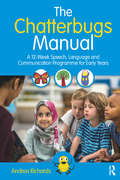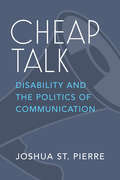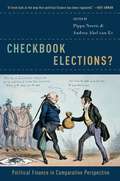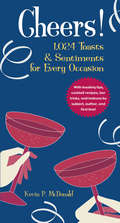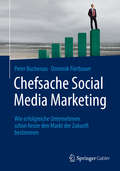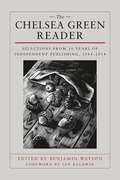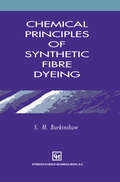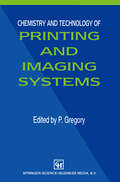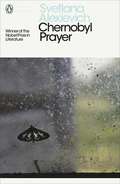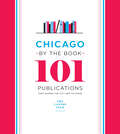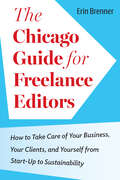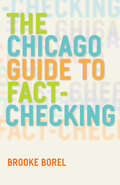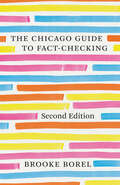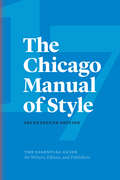- Table View
- List View
The Chatterbugs Manual: A 12-Week Speech, Language and Communication Programme for Early Years
by Andrea RichardsThe Chatterbugs Manual is a practical resource for all those supporting the development of the foundation communication skills of attention and listening, turn-taking and early vocabulary in children. The Chatterbugs programme has been designed to bridge the gap between education and specialist speech, language and communication provision, specifically with Early Years mainstream settings in mind. It enables school staff to prepare children—including those with delayed communication skills, EAL learners, or children with suspected special education needs—for learning in school by developing their communication skills through the use of robust communication strategies. The Chatterbugs Manual contains: An overview of the programme, including step-by-step instructions on how to plan and deliver a Chatterbugs session Guidance on identifying children likely to benefit from the programme Progress Tracking documents, along with information on measuring outcomes Child-friendly, illustrated session resources Frequently Asked Questions A parent-friendly information leaflet Information on models of implementation Information on accessing training and support Developed by an experienced speech and language therapist, Chatterbugs has consistently recorded successful outcomes for over 80% of participants since the programme’s inception in 2012, and for over 90% of participants since 2016. With its hands-on approach, the programme is an essential resource for educators, support staff, and speech and language therapists working with Early Years children.
Cheap Talk: Disability and the Politics of Communication (Corporealities: Discourses Of Disability)
by Joshua St. PierreIn Cheap Talk: Disability and the Politics of Communication, Joshua St. Pierre flips the script on communication disability, positioning the unruly, disabled speaker at the center of analysis to challenge the belief that more communication is unquestionably good. Working with Gilles Deleuze’s suggestion that “[w]e don’t suffer these days from any lack of communication, but rather from all the forces making us say things when we’ve nothing much to say,” St. Pierre brings together the unlikely trio of the dysfluent speaker, the talking head, and the troll to show how speech is made cheap—and produced and repaired within human bodies—to meet the inhuman needs of capital. The book explores how technologies, like social media and the field of speech-language pathology, create smooth sites of contact that are exclusionary for disabled speakers and looks to the political possibilities of disabled voices to “de-face” the power of speech now entwined with capital.
Checkbook Elections?: Political Finance in Comparative Perspective
Money is essential to the functioning of electoral politics, yet regulating its appropriate use raises complex and controversial challenges in countries around the world. Both long-established democracies and emerging economies have been continually plagued by problems of financial malfeasance, graft, corruption, and cronyism. To throw new light on these important challenges, this book addresses three related questions: (1) what types of public policies are commonly used in attempts to regulate the role of money in politics?, (2) what triggers landmark finance reforms? and, (3) above all, what works, what fails, and why - when countries implement reforms? Checkbook Elections? presents an original theory for understanding policies regulating political finance, reflecting the degree to which laws are laissez-faire or guided by state intervention. Each chapter is written by an area specialist and collectively cover long-established democracies as well as hybrid regimes, affluent post-industrial societies (Sweden, the United States, Britain, and Japan), major emerging economies (Russia, Brazil, and South Africa) and developing societies (India and Indonesia).
CHECKBOOK ELECTIONS? C: Political Finance in Comparative Perspective
by Pippa Norris and Andrea Abel VanesMoney is essential to the functioning of electoral politics, yet regulating its appropriate use raises complex and controversial challenges in countries around the world. Both long-established democracies and emerging economies have been continually plagued by problems of financial malfeasance, graft, corruption, and cronyism. To throw new light on these important challenges, this book addresses three related questions: (1) what types of public policies are commonly used in attempts to regulate the role of money in politics?, (2) what triggers landmark finance reforms? and, (3) above all, what works, what fails, and why - when countries implement reforms? Checkbook Elections? presents an original theory for understanding policies regulating political finance, reflecting the degree to which laws are laissez-faire or guided by state intervention. Each chapter is written by an area specialist and collectively cover long-established democracies as well as hybrid regimes, affluent post-industrial societies (Sweden, the United States, Britain, and Japan), major emerging economies (Russia, Brazil, and South Africa) and developing societies (India and Indonesia).
Cheers!: 1,024 Toasts & Sentiments for Every Occasion
by Kevin P. McDonaldCheers! is an indispensable A-to-Z of warm, funny, erudite, and sentimental sayings forevery possible occasion. Organized by category, Cheers! is more than a list of notable quotes and memorable toasts. It is full of useful advice on how to prepare a personalized message using the sayings in the book; deliver a toast without becoming flustered or, worse, running too long; and determine what words are appropriate for any given situation. An extended index and cross-references make Cheers! extremely easy to navigate, so finding the perfect words is a cinch.
Chefsache Social Media Marketing: Wie erfolgreiche Unternehmen schon heute den Markt der Zukunft bestimmen (Chefsache)
by Peter Buchenau Dominik FürtbauerDieser Band der beliebten "Chefsache"-Reihe zeigt Ihnen, wie Sie die Möglichkeiten der sozialen Netzwerke optimal für Ihr Unternehmen nutzen. Die Gesellschaft wandelt sich, Generationen prallen aufeinander. Es wird Zeit für ein neues Marketing, das die zukünftigen Kunden, die junge Generation, anspricht und Ihrem Unternehmen zu einem positiven Image bei dieser Zielgruppe verhilft. Die Autoren stellen die wichtigsten Social-Media-Plattformen vor, erläutern Strategien für das Marketing 2.0, beschreiben Methoden der Erfolgsmessung und zeigen, wie man Fehler beim Umgang mit den sozialen Medien vermeidet.
The Chelsea Green Reader: Selections from 30 Years of Independent Publishing, 1984-2014
by Ben Watson Ian BaldwinChelsea Green, the Vermont-based independent publisher, has always had a nose for authors and subjects that are way ahead of the cultural curve, as is evident in this new anthology celebrating the company’s first thirty years in publishing. The more than one hundred books represented in this collection reflect the many distinct areas in which we have published–from literature and memoirs to progressive politics, to highly practical books on green building, organic gardening and farming, food and health, and related subjects–all of which reflect our underlying philosophy: "The politics and practice of sustainable living." The Chelsea Green Reader offers a glimpse into our wide-ranging list of books and authors and to the important ideas that they express. Interesting and worth reading in their own right, the individual passages when taken as a whole trace the evolution of a highly successful small publisher–something that is almost an oxymoron in these days of corporate buyouts and multinational book groups. From the beginning, Chelsea Green's books were nationally recognized, garnering positive reviews, accolades, and awards. We’ve published four New York Times bestsellers, and our books have set the standard for in-depth, how-to books that remain relevant years–often decades–beyond their original publication date. "Chelsea Green was born from a single seed: the beauty of craft. Craft in writing and editing, in a story well told, or a thesis superbly expressed," writes cofounder and publisher emeritus Ian Baldwin in the book's foreword. Today, craft continues to inform all aspects of our work–design, illustration, production, sales, promotion, and beyond. It has even informed our business model: In 2012, Chelsea Green became an employee-owned company. With the rise of the Internet, new media platforms, and a constantly shifting bookselling landscape, the future of publishing is anything but predictable. But if Chelsea Green's books prove anything, it is that, despite these challenges, there remains a hunger for new and important ideas and authors, and for the permanence and craftsmanship of the printed word. Today our ongoing mission is stronger than ever, as we launch into our next thirty years of publishing excellence.
Chemical Principles of Synthetic Fibre Dyeing
by S.M. BurkinshawSynthetic fibres are widely used for many applications, with their colour being of major commercial importance. This extensively referenced book provides a comprehensive account of the physical chemistry of the dyeing of synthetic fibres and microfibres.
Chemistry and Technology of Printing and Imaging Systems
by P. GregoryPrinting and imaging has a major impact on everyone. From the obvious examples of newspapers, magazines and comics through to photographs, currency and credit cards, and even the less obvious example of compact discs, everyone is familiar with the end products of printing and imaging. Until recently, the major printing and imaging technologies have been impact printing and silver halide photography. Important impact printing technologies are offset lithography, gravure, flexography and screen printing. All these technologies, including silver halide photography, are mature and have changed little over the past few decades. In contrast, the phenomenal growth of silicon chip technology over the past 15 years or so has spawned a new era of printing and imaging systems, the so-called non impact (or electronic) printers. Not all the non-impact printing technologies are of equal commercial importance. Some, like diazotype and conventional photolithography, are mature and are declining in importance. Other technologies, though relatively new, have not achieved notable commercial success. Electro graphy and magnetography fall into this category. The remaining tech nologies such as optical data storage (the technology used in compact discs), thermography (the technology used in electronic photography), ink jet printing and electrophotography are the non-impact printing tech nologies that are both modern and which have achieved remarkable commercial success, especially ink-jet printing and electrophotography.
Chernobyl Prayer: A Chronicle of the Future
by Svetlana Alexievich Anna Gunin Arch TaitA startling history of the Chernobyl disaster by Svetlana Alexievich, the winner of the Nobel prize in literature 2015 On 26 April 1986, at 1.23am, a series of explosions shook the Chernobyl nuclear reactor. Flames lit up the sky and radiation escaped to contaminate the land and poison the people for years to come. While officials tried to hush up the accident, Svetlana Alexievich spent years collecting testimonies from survivors - clean-up workers, residents, firefighters, resettlers, widows, orphans - crafting their voices into a haunting oral history of fear, anger and uncertainty, but also dark humour and love. A chronicle of the past and a warning for our nuclear future, Chernobyl Prayer shows what it is like to bear witness, and remember in a world that wants you to forget.
Chicago by the Book: 101 Publications That Shaped the City and Its Image
by Caxton ClubDespite its rough-and-tumble image, Chicago has long been identified as a city where books take center stage. In fact, a volume by A. J. Liebling gave the Second City its nickname. Upton Sinclair’s The Jungle arose from the midwestern capital’s most infamous industry. The great Chicago Fire led to the founding of the Chicago Public Library. The city has fostered writers such as Nelson Algren, Saul Bellow, and Gwendolyn Brooks. Chicago’s literary magazines The Little Review and Poetry introduced the world to Eliot, Hemingway, Joyce, and Pound. The city’s robust commercial printing industry supported a flourishing culture of the book. With this beautifully produced collection, Chicago’s rich literary tradition finally gets its due. Chicago by the Book profiles 101 landmark publications about Chicago from the past 170 years that have helped define the city and its image. Each title—carefully selected by the Caxton Club, a venerable Chicago bibliophilic organization—is the focus of an illustrated essay by a leading scholar, writer, or bibliophile. Arranged chronologically to show the history of both the city and its books, the essays can be read in order from Mrs. John H. Kinzie’s 1844 Narrative of the Massacre of Chicago to Sara Paretsky’s 2015 crime novel Brush Back. Or one can dip in and out, savoring reflections on the arts, sports, crime, race relations, urban planning, politics, and even Mrs. O’Leary’s legendary cow. The selections do not shy from the underside of the city, recognizing that its grit and graft have as much a place in the written imagination as soaring odes and boosterism. As Neil Harris observes in his introduction, “Even when Chicagoans celebrate their hearth and home, they do so while acknowledging deep-seated flaws.” At the same time, this collection heartily reminds us all of what makes Chicago, as Norman Mailer called it, the “great American city.” With essays from, among others, Ira Berkow, Thomas Dyja, Ann Durkin Keating, Alex Kotlowitz, Toni Preckwinkle, Frank Rich, Don Share, Carl Smith, Regina Taylor, Garry Wills, and William Julius Wilson; and featuring works by Saul Bellow, Gwendolyn Brooks, Sandra Cisneros, Clarence Darrow, Erik Larson, David Mamet, Studs Terkel, Ida B. Wells-Barnett, Frank Lloyd Wright, and many more.
Chicago by the Book: 101 Publications That Shaped the City and Its Image
by Caxton ClubDespite its rough-and-tumble image, Chicago has long been identified as a city where books take center stage. In fact, a volume by A. J. Liebling gave the Second City its nickname. Upton Sinclair’s The Jungle arose from the midwestern capital’s most infamous industry. The great Chicago Fire led to the founding of the Chicago Public Library. The city has fostered writers such as Nelson Algren, Saul Bellow, and Gwendolyn Brooks. Chicago’s literary magazines The Little Review and Poetry introduced the world to Eliot, Hemingway, Joyce, and Pound. The city’s robust commercial printing industry supported a flourishing culture of the book. With this beautifully produced collection, Chicago’s rich literary tradition finally gets its due. Chicago by the Book profiles 101 landmark publications about Chicago from the past 170 years that have helped define the city and its image. Each title—carefully selected by the Caxton Club, a venerable Chicago bibliophilic organization—is the focus of an illustrated essay by a leading scholar, writer, or bibliophile. Arranged chronologically to show the history of both the city and its books, the essays can be read in order from Mrs. John H. Kinzie’s 1844 Narrative of the Massacre of Chicago to Sara Paretsky’s 2015 crime novel Brush Back. Or one can dip in and out, savoring reflections on the arts, sports, crime, race relations, urban planning, politics, and even Mrs. O’Leary’s legendary cow. The selections do not shy from the underside of the city, recognizing that its grit and graft have as much a place in the written imagination as soaring odes and boosterism. As Neil Harris observes in his introduction, “Even when Chicagoans celebrate their hearth and home, they do so while acknowledging deep-seated flaws.” At the same time, this collection heartily reminds us all of what makes Chicago, as Norman Mailer called it, the “great American city.” With essays from, among others, Ira Berkow, Thomas Dyja, Ann Durkin Keating, Alex Kotlowitz, Toni Preckwinkle, Frank Rich, Don Share, Carl Smith, Regina Taylor, Garry Wills, and William Julius Wilson; and featuring works by Saul Bellow, Gwendolyn Brooks, Sandra Cisneros, Clarence Darrow, Erik Larson, David Mamet, Studs Terkel, Ida B. Wells-Barnett, Frank Lloyd Wright, and many more.
Chicago by the Book: 101 Publications That Shaped the City and Its Image
by Caxton ClubDespite its rough-and-tumble image, Chicago has long been identified as a city where books take center stage. In fact, a volume by A. J. Liebling gave the Second City its nickname. Upton Sinclair’s The Jungle arose from the midwestern capital’s most infamous industry. The great Chicago Fire led to the founding of the Chicago Public Library. The city has fostered writers such as Nelson Algren, Saul Bellow, and Gwendolyn Brooks. Chicago’s literary magazines The Little Review and Poetry introduced the world to Eliot, Hemingway, Joyce, and Pound. The city’s robust commercial printing industry supported a flourishing culture of the book. With this beautifully produced collection, Chicago’s rich literary tradition finally gets its due. Chicago by the Book profiles 101 landmark publications about Chicago from the past 170 years that have helped define the city and its image. Each title—carefully selected by the Caxton Club, a venerable Chicago bibliophilic organization—is the focus of an illustrated essay by a leading scholar, writer, or bibliophile. Arranged chronologically to show the history of both the city and its books, the essays can be read in order from Mrs. John H. Kinzie’s 1844 Narrative of the Massacre of Chicago to Sara Paretsky’s 2015 crime novel Brush Back. Or one can dip in and out, savoring reflections on the arts, sports, crime, race relations, urban planning, politics, and even Mrs. O’Leary’s legendary cow. The selections do not shy from the underside of the city, recognizing that its grit and graft have as much a place in the written imagination as soaring odes and boosterism. As Neil Harris observes in his introduction, “Even when Chicagoans celebrate their hearth and home, they do so while acknowledging deep-seated flaws.” At the same time, this collection heartily reminds us all of what makes Chicago, as Norman Mailer called it, the “great American city.” With essays from, among others, Ira Berkow, Thomas Dyja, Ann Durkin Keating, Alex Kotlowitz, Toni Preckwinkle, Frank Rich, Don Share, Carl Smith, Regina Taylor, Garry Wills, and William Julius Wilson; and featuring works by Saul Bellow, Gwendolyn Brooks, Sandra Cisneros, Clarence Darrow, Erik Larson, David Mamet, Studs Terkel, Ida B. Wells-Barnett, Frank Lloyd Wright, and many more.
Chicago by the Book: 101 Publications That Shaped the City and Its Image
by Caxton ClubDespite its rough-and-tumble image, Chicago has long been identified as a city where books take center stage. In fact, a volume by A. J. Liebling gave the Second City its nickname. Upton Sinclair’s The Jungle arose from the midwestern capital’s most infamous industry. The great Chicago Fire led to the founding of the Chicago Public Library. The city has fostered writers such as Nelson Algren, Saul Bellow, and Gwendolyn Brooks. Chicago’s literary magazines The Little Review and Poetry introduced the world to Eliot, Hemingway, Joyce, and Pound. The city’s robust commercial printing industry supported a flourishing culture of the book. With this beautifully produced collection, Chicago’s rich literary tradition finally gets its due. Chicago by the Book profiles 101 landmark publications about Chicago from the past 170 years that have helped define the city and its image. Each title—carefully selected by the Caxton Club, a venerable Chicago bibliophilic organization—is the focus of an illustrated essay by a leading scholar, writer, or bibliophile. Arranged chronologically to show the history of both the city and its books, the essays can be read in order from Mrs. John H. Kinzie’s 1844 Narrative of the Massacre of Chicago to Sara Paretsky’s 2015 crime novel Brush Back. Or one can dip in and out, savoring reflections on the arts, sports, crime, race relations, urban planning, politics, and even Mrs. O’Leary’s legendary cow. The selections do not shy from the underside of the city, recognizing that its grit and graft have as much a place in the written imagination as soaring odes and boosterism. As Neil Harris observes in his introduction, “Even when Chicagoans celebrate their hearth and home, they do so while acknowledging deep-seated flaws.” At the same time, this collection heartily reminds us all of what makes Chicago, as Norman Mailer called it, the “great American city.” With essays from, among others, Ira Berkow, Thomas Dyja, Ann Durkin Keating, Alex Kotlowitz, Toni Preckwinkle, Frank Rich, Don Share, Carl Smith, Regina Taylor, Garry Wills, and William Julius Wilson; and featuring works by Saul Bellow, Gwendolyn Brooks, Sandra Cisneros, Clarence Darrow, Erik Larson, David Mamet, Studs Terkel, Ida B. Wells-Barnett, Frank Lloyd Wright, and many more.
The Chicago Guide for Freelance Editors: How to Take Care of Your Business, Your Clients, and Yourself from Start-Up to Sustainability (Chicago Guides to Writing, Editing, and Publishing)
by Erin BrennerThe definitive guide to starting and running a freelance editing business. You’ve been thinking about shifting into the world of freelance editing, but you don’t know where to start. In a time when editors are seeking greater flexibility in their work arrangements and schedules, freelancing is an increasingly common career option. But deciding to go it alone means balancing the risks with the rewards. From the publisher of The Chicago Manual of Style comes The Chicago Guide for Freelance Editors, the definitive guide to running your business and finding greater control and freedom in your work life. In this book, Erin Brenner—an industry leader and expert on the business of editorial freelancing—gathers everything you need to know into a single resource. Brenner has run her own successful editing business for over two decades and has helped hundreds of editors launch or improve their businesses through her teaching, blog writing, and coaching. The Chicago Guide for Freelance Editors will walk you through the entire process of conceiving, launching, and working in a freelance editing business, from deciding on services and rates to choosing the best business structure to thinking through branding and marketing strategies and beyond. This book is ideal for beginning freelancers looking to get set up and land their first clients, but it’s equally valuable to those who have already been freelancing, with detailed coverage of such issues as handling difficult clients and continuing professional development. You’ll find a collection of advice from other successful freelance editors in this guide, as well as an extensive list of resources and tools. In the final and perhaps most important chapter, Brenner teaches you how to care for the key component of the business: yourself.
The Chicago Guide for Freelance Editors: How to Take Care of Your Business, Your Clients, and Yourself from Start-Up to Sustainability (Chicago Guides to Writing, Editing, and Publishing)
by Erin BrennerThe definitive guide to starting and running a freelance editing business. You’ve been thinking about shifting into the world of freelance editing, but you don’t know where to start. In a time when editors are seeking greater flexibility in their work arrangements and schedules, freelancing is an increasingly common career option. But deciding to go it alone means balancing the risks with the rewards. From the publisher of The Chicago Manual of Style comes The Chicago Guide for Freelance Editors, the definitive guide to running your business and finding greater control and freedom in your work life. In this book, Erin Brenner—an industry leader and expert on the business of editorial freelancing—gathers everything you need to know into a single resource. Brenner has run her own successful editing business for over two decades and has helped hundreds of editors launch or improve their businesses through her teaching, blog writing, and coaching. The Chicago Guide for Freelance Editors will walk you through the entire process of conceiving, launching, and working in a freelance editing business, from deciding on services and rates to choosing the best business structure to thinking through branding and marketing strategies and beyond. This book is ideal for beginning freelancers looking to get set up and land their first clients, but it’s equally valuable to those who have already been freelancing, with detailed coverage of such issues as handling difficult clients and continuing professional development. You’ll find a collection of advice from other successful freelance editors in this guide, as well as an extensive list of resources and tools. In the final and perhaps most important chapter, Brenner teaches you how to care for the key component of the business: yourself.
The Chicago Guide to Fact-Checking (Chicago Guides to Writing, Editing, and Publishing)
by Brooke Borel“A column by Glenn Garvin on Dec. 20 stated that the National Science Foundation ‘funded a study on Jell-O wrestling at the South Pole.’ That is incorrect. The event took place during off-duty hours without NSF permission and did not involve taxpayer funds.” Corrections such as this one from the Miami Herald have become a familiar sight for readers, especially as news cycles demand faster and faster publication. While some factual errors can be humorous, they nonetheless erode the credibility of the writer and the organization. And the pressure for accuracy and accountability is increasing at the same time as in-house resources for fact-checking are dwindling. Anyone who needs or wants to learn how to verify names, numbers, quotations, and facts is largely on their own. Enter The Chicago Guide to Fact-Checking, an accessible, one-stop guide to the why, what, and how of contemporary fact-checking. Brooke Borel, an experienced fact-checker, draws on the expertise of more than 200 writers, editors, and fellow checkers representing the New Yorker, Popular Science, This American Life, Vogue, and many other outlets. She covers best practices for fact-checking in a variety of media—from magazine articles, both print and online, to books and documentaries—and from the perspective of both in-house and freelance checkers. She also offers advice on navigating relationships with writers, editors, and sources; considers the realities of fact-checking on a budget and checking one’s own work; and reflects on the place of fact-checking in today’s media landscape. “If journalism is a cornerstone of democracy, then fact-checking is its building inspector,” Borel writes. The Chicago Guide to Fact-Checking is the practical—and thoroughly vetted—guide that writers, editors, and publishers need to maintain their credibility and solidify their readers’ trust.
The Chicago Guide to Fact-Checking (Chicago Guides to Writing, Editing, and Publishing)
by Brooke Borel“A column by Glenn Garvin on Dec. 20 stated that the National Science Foundation ‘funded a study on Jell-O wrestling at the South Pole.’ That is incorrect. The event took place during off-duty hours without NSF permission and did not involve taxpayer funds.” Corrections such as this one from the Miami Herald have become a familiar sight for readers, especially as news cycles demand faster and faster publication. While some factual errors can be humorous, they nonetheless erode the credibility of the writer and the organization. And the pressure for accuracy and accountability is increasing at the same time as in-house resources for fact-checking are dwindling. Anyone who needs or wants to learn how to verify names, numbers, quotations, and facts is largely on their own. Enter The Chicago Guide to Fact-Checking, an accessible, one-stop guide to the why, what, and how of contemporary fact-checking. Brooke Borel, an experienced fact-checker, draws on the expertise of more than 200 writers, editors, and fellow checkers representing the New Yorker, Popular Science, This American Life, Vogue, and many other outlets. She covers best practices for fact-checking in a variety of media—from magazine articles, both print and online, to books and documentaries—and from the perspective of both in-house and freelance checkers. She also offers advice on navigating relationships with writers, editors, and sources; considers the realities of fact-checking on a budget and checking one’s own work; and reflects on the place of fact-checking in today’s media landscape. “If journalism is a cornerstone of democracy, then fact-checking is its building inspector,” Borel writes. The Chicago Guide to Fact-Checking is the practical—and thoroughly vetted—guide that writers, editors, and publishers need to maintain their credibility and solidify their readers’ trust.
The Chicago Guide to Fact-Checking (Chicago Guides to Writing, Editing, and Publishing)
by Brooke Borel“A column by Glenn Garvin on Dec. 20 stated that the National Science Foundation ‘funded a study on Jell-O wrestling at the South Pole.’ That is incorrect. The event took place during off-duty hours without NSF permission and did not involve taxpayer funds.” Corrections such as this one from the Miami Herald have become a familiar sight for readers, especially as news cycles demand faster and faster publication. While some factual errors can be humorous, they nonetheless erode the credibility of the writer and the organization. And the pressure for accuracy and accountability is increasing at the same time as in-house resources for fact-checking are dwindling. Anyone who needs or wants to learn how to verify names, numbers, quotations, and facts is largely on their own. Enter The Chicago Guide to Fact-Checking, an accessible, one-stop guide to the why, what, and how of contemporary fact-checking. Brooke Borel, an experienced fact-checker, draws on the expertise of more than 200 writers, editors, and fellow checkers representing the New Yorker, Popular Science, This American Life, Vogue, and many other outlets. She covers best practices for fact-checking in a variety of media—from magazine articles, both print and online, to books and documentaries—and from the perspective of both in-house and freelance checkers. She also offers advice on navigating relationships with writers, editors, and sources; considers the realities of fact-checking on a budget and checking one’s own work; and reflects on the place of fact-checking in today’s media landscape. “If journalism is a cornerstone of democracy, then fact-checking is its building inspector,” Borel writes. The Chicago Guide to Fact-Checking is the practical—and thoroughly vetted—guide that writers, editors, and publishers need to maintain their credibility and solidify their readers’ trust.
The Chicago Guide to Fact-Checking (Chicago Guides to Writing, Editing, and Publishing)
by Brooke Borel“A column by Glenn Garvin on Dec. 20 stated that the National Science Foundation ‘funded a study on Jell-O wrestling at the South Pole.’ That is incorrect. The event took place during off-duty hours without NSF permission and did not involve taxpayer funds.” Corrections such as this one from the Miami Herald have become a familiar sight for readers, especially as news cycles demand faster and faster publication. While some factual errors can be humorous, they nonetheless erode the credibility of the writer and the organization. And the pressure for accuracy and accountability is increasing at the same time as in-house resources for fact-checking are dwindling. Anyone who needs or wants to learn how to verify names, numbers, quotations, and facts is largely on their own. Enter The Chicago Guide to Fact-Checking, an accessible, one-stop guide to the why, what, and how of contemporary fact-checking. Brooke Borel, an experienced fact-checker, draws on the expertise of more than 200 writers, editors, and fellow checkers representing the New Yorker, Popular Science, This American Life, Vogue, and many other outlets. She covers best practices for fact-checking in a variety of media—from magazine articles, both print and online, to books and documentaries—and from the perspective of both in-house and freelance checkers. She also offers advice on navigating relationships with writers, editors, and sources; considers the realities of fact-checking on a budget and checking one’s own work; and reflects on the place of fact-checking in today’s media landscape. “If journalism is a cornerstone of democracy, then fact-checking is its building inspector,” Borel writes. The Chicago Guide to Fact-Checking is the practical—and thoroughly vetted—guide that writers, editors, and publishers need to maintain their credibility and solidify their readers’ trust.
The Chicago Guide to Fact-Checking (Chicago Guides to Writing, Editing, and Publishing)
by Brooke Borel“A column by Glenn Garvin on Dec. 20 stated that the National Science Foundation ‘funded a study on Jell-O wrestling at the South Pole.’ That is incorrect. The event took place during off-duty hours without NSF permission and did not involve taxpayer funds.” Corrections such as this one from the Miami Herald have become a familiar sight for readers, especially as news cycles demand faster and faster publication. While some factual errors can be humorous, they nonetheless erode the credibility of the writer and the organization. And the pressure for accuracy and accountability is increasing at the same time as in-house resources for fact-checking are dwindling. Anyone who needs or wants to learn how to verify names, numbers, quotations, and facts is largely on their own. Enter The Chicago Guide to Fact-Checking, an accessible, one-stop guide to the why, what, and how of contemporary fact-checking. Brooke Borel, an experienced fact-checker, draws on the expertise of more than 200 writers, editors, and fellow checkers representing the New Yorker, Popular Science, This American Life, Vogue, and many other outlets. She covers best practices for fact-checking in a variety of media—from magazine articles, both print and online, to books and documentaries—and from the perspective of both in-house and freelance checkers. She also offers advice on navigating relationships with writers, editors, and sources; considers the realities of fact-checking on a budget and checking one’s own work; and reflects on the place of fact-checking in today’s media landscape. “If journalism is a cornerstone of democracy, then fact-checking is its building inspector,” Borel writes. The Chicago Guide to Fact-Checking is the practical—and thoroughly vetted—guide that writers, editors, and publishers need to maintain their credibility and solidify their readers’ trust.
The Chicago Guide to Fact-Checking (Chicago Guides to Writing, Editing, and Publishing)
by Brooke Borel“A column by Glenn Garvin on Dec. 20 stated that the National Science Foundation ‘funded a study on Jell-O wrestling at the South Pole.’ That is incorrect. The event took place during off-duty hours without NSF permission and did not involve taxpayer funds.” Corrections such as this one from the Miami Herald have become a familiar sight for readers, especially as news cycles demand faster and faster publication. While some factual errors can be humorous, they nonetheless erode the credibility of the writer and the organization. And the pressure for accuracy and accountability is increasing at the same time as in-house resources for fact-checking are dwindling. Anyone who needs or wants to learn how to verify names, numbers, quotations, and facts is largely on their own. Enter The Chicago Guide to Fact-Checking, an accessible, one-stop guide to the why, what, and how of contemporary fact-checking. Brooke Borel, an experienced fact-checker, draws on the expertise of more than 200 writers, editors, and fellow checkers representing the New Yorker, Popular Science, This American Life, Vogue, and many other outlets. She covers best practices for fact-checking in a variety of media—from magazine articles, both print and online, to books and documentaries—and from the perspective of both in-house and freelance checkers. She also offers advice on navigating relationships with writers, editors, and sources; considers the realities of fact-checking on a budget and checking one’s own work; and reflects on the place of fact-checking in today’s media landscape. “If journalism is a cornerstone of democracy, then fact-checking is its building inspector,” Borel writes. The Chicago Guide to Fact-Checking is the practical—and thoroughly vetted—guide that writers, editors, and publishers need to maintain their credibility and solidify their readers’ trust.
The Chicago Guide to Fact-Checking, Second Edition (Chicago Guides to Writing, Editing, and Publishing)
by Brooke BorelThis book will help you: Recognize what information to fact-check Identify the quality and ranking of source materials Learn to fact-check a variety of media types: newspaper; magazine; social media; public and commercial radio and television, books, films, etc. Navigate relationships with editors, writers, and producers Recognize plagiarism and fabrication Discern conflicting facts, gray areas, and litigious materials Learn record keeping best practices for tracking sources Test your own fact-checking skills An accessible, one-stop guide to the why, what, and how of contemporary editorial fact-checking. Over the past few years, fact-checking has been widely touted as a corrective to the spread of misinformation, disinformation, conspiracy theories, and propaganda through the media. “If journalism is a cornerstone of democracy,” says author Brooke Borel, “then fact-checking is its building inspector.” In The Chicago Guide to Fact-Checking, Borel, an experienced fact-checker, draws on the expertise of more than 200 writers, editors, and fellow checkers representing the New Yorker, Popular Science, This American Life, Vogue, and many other outlets. She covers best practices for editorial fact-checking in a variety of media—from magazine and news articles, both print and online, to books and podcasts—and the perspectives of both in-house and freelance checkers. In this second edition, Borel covers the evolving media landscape, with new guidance on checking audio and video sources, polling data, and sensitive subjects such as trauma and abuse. The sections on working with writers, editors, and producers have been expanded, and new material includes fresh exercises and advice on getting fact-checking gigs. Borel also addresses the challenges of fact-checking in a world where social media, artificial intelligence, and the metaverse may make it increasingly difficult for everyone—including fact-checkers—to identify false information. The answer, she says, is for everyone to approach information with skepticism—to learn to think like a fact-checker. The Chicago Guide to Fact-Checking is the practical—and thoroughly vetted—guide that writers, editors, and publishers continue to consult to maintain their credibility and solidify their readers’ trust.
The Chicago Guide to Fact-Checking, Second Edition (Chicago Guides to Writing, Editing, and Publishing)
by Brooke BorelThis book will help you: Recognize what information to fact-check Identify the quality and ranking of source materials Learn to fact-check a variety of media types: newspaper; magazine; social media; public and commercial radio and television, books, films, etc. Navigate relationships with editors, writers, and producers Recognize plagiarism and fabrication Discern conflicting facts, gray areas, and litigious materials Learn record keeping best practices for tracking sources Test your own fact-checking skills An accessible, one-stop guide to the why, what, and how of contemporary editorial fact-checking. Over the past few years, fact-checking has been widely touted as a corrective to the spread of misinformation, disinformation, conspiracy theories, and propaganda through the media. “If journalism is a cornerstone of democracy,” says author Brooke Borel, “then fact-checking is its building inspector.” In The Chicago Guide to Fact-Checking, Borel, an experienced fact-checker, draws on the expertise of more than 200 writers, editors, and fellow checkers representing the New Yorker, Popular Science, This American Life, Vogue, and many other outlets. She covers best practices for editorial fact-checking in a variety of media—from magazine and news articles, both print and online, to books and podcasts—and the perspectives of both in-house and freelance checkers. In this second edition, Borel covers the evolving media landscape, with new guidance on checking audio and video sources, polling data, and sensitive subjects such as trauma and abuse. The sections on working with writers, editors, and producers have been expanded, and new material includes fresh exercises and advice on getting fact-checking gigs. Borel also addresses the challenges of fact-checking in a world where social media, artificial intelligence, and the metaverse may make it increasingly difficult for everyone—including fact-checkers—to identify false information. The answer, she says, is for everyone to approach information with skepticism—to learn to think like a fact-checker. The Chicago Guide to Fact-Checking is the practical—and thoroughly vetted—guide that writers, editors, and publishers continue to consult to maintain their credibility and solidify their readers’ trust.
The Chicago Manual of Style, 17th Edition
by The University of Chicago Press Editorial StaffTechnologies may change, but the need for clear and accurate communication never goes out of style. That is why for more than one hundred years The Chicago Manual of Style has remained the definitive guide for anyone who works with words. In the seven years since the previous edition debuted, we have seen an extraordinary evolution in the way we create and share knowledge. This seventeenth edition of The Chicago Manual of Style has been prepared with an eye toward how we find, create, and cite information that readers are as likely to access from their pockets as from a bookshelf. It offers updated guidelines on electronic workflows and publication formats, tools for PDF annotation and citation management, web accessibility standards, and effective use of metadata, abstracts, and keywords. It recognizes the needs of those who are self-publishing or following open access or Creative Commons publishing models. The citation chapters reflect the ever-expanding universe of electronic sources—including social media posts and comments, private messages, and app content—and also offer updated guidelines on such issues as DOIs, time stamps, and e-book locators. Other improvements are independent of technological change. The chapter on grammar and usage includes an expanded glossary of problematic words and phrases and a new section on syntax as well as updated guidance on gender-neutral pronouns and bias-free language. Key sections on punctuation and basic citation style have been reorganized and clarified. To facilitate navigation, headings and paragraph titles have been revised and clarified throughout. And the bibliography has been updated and expanded to include the latest and best resources available. This edition continues to reflect expert insights gathered from Chicago’s own staff and from an advisory board of publishing experts from across the profession. It also includes suggestions inspired by emails, calls, and even tweets from readers. No matter how much the means of communication change, The Chicago Manual of Style remains the ultimate resource for those who care about getting the details right.
